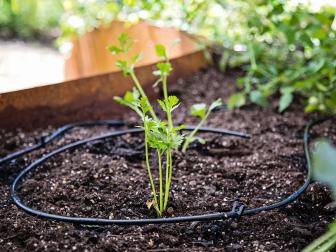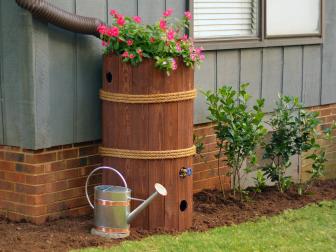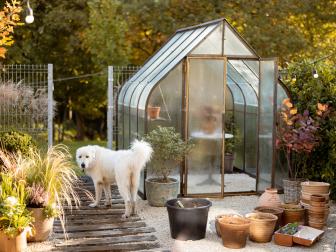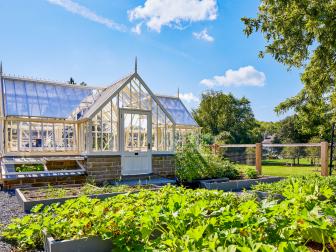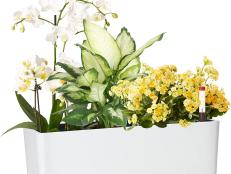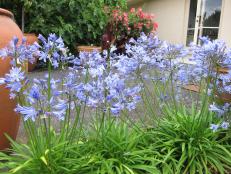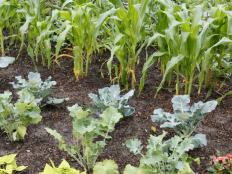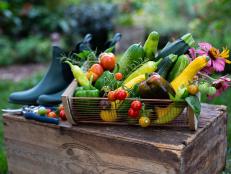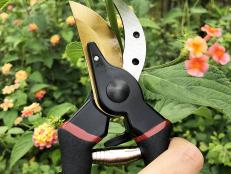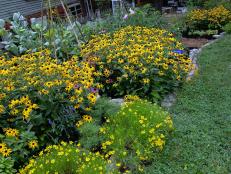How to Set Up Water and Lighting in a Greenhouse
Water and light are essential to plants, and in a greenhouse, you'll provide both.

Now that you’ve stuck a roof over your plants by placing them in your greenhouse, you’re solely responsible for fulfilling their light and watering needs. The best time to consider greenhouse irrigation and lighting is when you’re first setting up so you can get the infrastructure right, but it’s an ongoing process. Since your chosen plants will dictate the specifics of the artificial sun and rain you’ll provide, your needs may change as your greenhouse evolves.

Shutterstock
Plant watering techniques include overhead and soil watering and some plants are choosy about which they prefer.
Greenhouse Watering Systems
Just like in nature, water is provided to plants in two ways in a greenhouse — from overhead and through the soil.
Overhead watering options include manually using a hose or watering can, or you can employ mounted misters and sprinklers that deliver water to plants and soil in a wide spray. Misters are appropriate for plants that like high humidity because they release a little water frequently, whereas sprinklers take the place of vigorous hand-watering.
The Best Garden Hoses, Tested by HGTV Editors
Learn the basics of garden hoses, and choose the right one for your yard and garden with HGTV editors' top recommendations.
Soil watering methods are more efficient than overhead techniques because they can be targeted and lose less water to evaporation. Self-watering trays and capillary mats have reservoirs you fill every so often that then provide water to the plant’s roots from below. Soaker hoses are placed on top of your soil and have pores throughout that leak water consistently. Drip irrigation also delivers small amounts of water over long periods so that plants stay uniformly moist. These systems come in tubes or tape; can operate on the soil surface or be embedded; and are more nuanced than soaker hoses in that they can be set up to deliver water directly where you want it.
How to Install a DIY Drip Irrigation System
Learn how to install a highly efficient water delivery system that will help keep your landscape and gardens stay lush and quenched.
Drip irrigation, misters and sprinklers can be set on timers. Timers come in wind-up, solar, battery-powered and electric versions. And, like everything else, there are models available that can be controlled by your phone.
In terms of water sources, you’ll likely get most of your greenhouse water from your municipal water supply or well, but you can reduce your need for these sources by using water collected on your property. For example, a rain barrel or even a pond on your property can be easily connected to the drip irrigation system we mentioned. Greywater — the water you generate in your home when you wash dishes, clothes and your family — can be safely repurposed on many plants. You can go all-in on a graywater system that separates the wastewater in your home; but you can also low-tech it in a watering can, collecting graywater from cooking produce, rinsing dishware and from pet's water bowls. For more info, visit the Treehugger blog’s great primer on the topic.
How to Make a Rain Barrel 25 Photos
Don't let that rainwater go to waste. This easy, recycled rain barrel project puts money back in your pocket.
Lighting a Greenhouse
Since a greenhouse is a structure that consists mostly of glazing, it’s easy to forget that plants may desire — or even require — artificial light. Grow lights will do a few things for your greenhouse:
- Support propagation areas: What you are germinating or propagating determines how long you need to leave the lights on, usually an average of 12 to 16 hours each day.
- Alter the photoperiod: The number of sunlight hours will impact growth and flowering.
- Provide the opportunity to grow plant varieties exotic to your region: For example, if tropical plants don't get at least eight hours of sun each day, you will need to make up the difference.
- Increase the yield of fruits and vegetables and the number of blooms on florals.
- Provide targeted light to specific shady spots. For some wannabe greenhousers living with less-than-perfect sun exposure, artificial light can even be the difference between having a greenhouse or not.
The fact is that most plants benefit from some artificial light. You’ll encounter some important terminology when shopping, including:
- Lumens: Plants require specific light intensity or brightness (lumens) to thrive. We used to consider wattage as an indicator of bulb brightness but no longer: New, energy-efficient bulbs sharing shelf space with less efficient bulbs of the same brightness has made lumens the standard of comparison between the different technologies. All wattage tells you is the power consumption of the bulb.
- Kelvin rating or color temperature: During particular stages in their life cycles, plants prefer different colors of light. The blue lightbulbs with higher Kelvin ratings (6500K) mimic daylight and are good for green growth, and warm lightbulbs with lower Kelvin ratings (2000K to 3000K) promote flowering and fruiting in plants. Full-spectrum lights support all stages of growth.
- Smart: Bulbs advertised as smart can be controlled remotely and often have manipulatable color temperature and brightness.
Types of bulbs available:
High-intensity fluorescent lightbulbs are a cheap, easy greenhouse lighting option. Note: The fluorescent bulbs in your garage are not what your plants want or need. The multi-bulb fixtures with T-5 tubes are the fluorescent standard for greenhouses. T-5 bulbs come at both ends of the color spectrum and are inexpensive, reliable and last a pretty long time.
High-intensity discharge (HID) lighting includes two types of bulbs: metal halide and high-pressure sodium (HPS). They operate at either end of the color spectrum, metal halide providing the daylight and HPS providing the warm light. HID bulbs are more powerful than high-intensity fluorescents, but they also use more power so cost more to run. That high power also translates to more heat, so you have to mount them a safe distance above plants to avoid heat burn. For example, a 125-watt HPS bulb gives off plenty of light when hung at least 3 feet above plants or seeds.
LED lighting is the obvious choice for many greenhouse growers for a few reasons. You’ll love how little power LEDs use — a fraction of that of HID lights for the same brightness. That efficiency translates to low amounts of heat produced, too. The upfront cost for a good LED fixture is high, but the good ones should pay for themselves over competing technologies through their low operating cost and long life. There are a couple of things to be mindful of with this technology:
- LED lights are highly specific (in terms of color and brightness, but also the direction and beam size of the light they cast).
- LED lights can be delicate and finicky about use with some dimmers, timers and other controllers.
- The product quality varies widely.
To get the purchase right, select LED fixtures advertised for greenhouse use and that are tested, warrantied and recommended.
Incandescent lighting used to be more common in greenhouses as the warm light ideal for the flowering stage, but they cost a lot to operate and produce a lot of heat. With the phaseout of incandescent and halogen bulbs for more efficient substitutes, we don’t use them much anymore.
You may wonder about solar lighting as an option in a greenhouse. Unfortunately, solar lights will fail to produce enough of the quality and consistency of light your plants need. But growers are less picky and, hey, once you buy the fixture, free light! Remember, lighting in a greenhouse serves two purposes: for the plants and for the grower. Those solar lights or even your trusty old incandescent bistro lights are ready to provide ambient and path lighting. But you also need sufficiently bright task lighting in some areas, best provided by fluorescent or LED fixtures.

Richardson Architects
Organizing the interior of your greenhouse may involve some trial and error but getting the infrastructure in place from the beginning will set you up for success. Plants can thrive in this property's expansive greenhouse equipped with state-of-the-art ventilation and watering systems.
Recommendations
Setting up a greenhouse is usually an ongoing project, as you discover the aspects of your layout that are working for you — or not — but that’s part of the fun. If you can get your utilities right from the get-go, it’ll save you heartache and expense later. Plan for electricity and irrigation, including the mounting needs of both light and watering systems, before erecting the greenhouse.
Greenhouse expert Scott Naegeli says a drip irrigation system is easy to lay out and is very cost-effective. Installation is also fairly simple:
- Be sure the mainline that carries water into the greenhouse is sunk underground at least 4 feet, which is below the frost line, to make sure the water in the line doesn't freeze.
- Use a 3/4" poly pipe as the water supply line. Position it to run down the length of the bench.
- From the main line, connect lateral lines to run between pots.
- Set the system on a timer to ensure regular watering.
Regardless of what plant irrigation method you choose, you can make your greenhouse more irrigator-friendly by incorporating grower conveniences inside like a potting station with a plumbed sink and a hose reel or trolley. Don’t forget the water timer Naegeli mentions, and you can save yourself from a 5 a.m. alarm if you invest in light timers, too.
Finish Setting Up the Greenhouse
Choosing a Greenhouse
Careful planning will pay off when selecting and putting up a greenhouse.
How to Heat a Greenhouse
Learn the essentials of greenhouse climate control.
25 Garden Tools and Essentials for Year-Round Care
When you're ready to grow, use our green-thumb shopping list to find great garden tools, gear and more.







